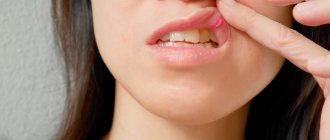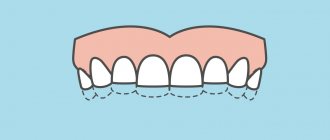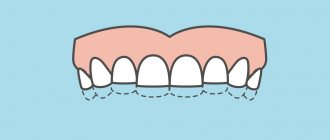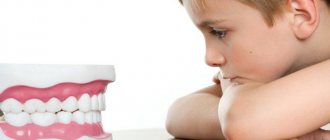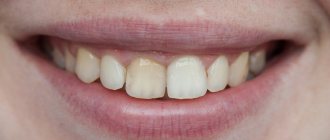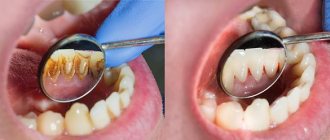A tooth injury is a bruise, dislocation or fracture as a result of a blow, fall or other mechanical impact. Most typical:
- Injury to the front milk teeth in children aged 1-2 years, when children are just starting to walk, but still have poor coordination of movements, often fall and hurt themselves, and run into hard objects.
- Dental trauma at the age of 7-10 years, when children learn to rollerblade and skateboard, play ball, climb, and sometimes fight.
Chronic injury is also possible when a child constantly chews hard objects, and chips of enamel and microcracks appear on the teeth.
IMPORTANT! Information from the article cannot be used for self-diagnosis and self-medication! Only a doctor can prescribe the necessary examinations, establish a diagnosis and draw up a treatment plan during a consultation!
Bruised baby tooth in a child
Most often, bruises occur in preschool children with baby teeth. In appearance, the bruised tooth may not be in an arch with the rest of the teeth, it may look slightly raised above the other teeth due to swelling of the gums. The tooth hurts when chewing and pressing. If a child’s tooth is bruised, what should parents do? The best thing to do in this case is to apply cold to the area of swelling on the face and take the child to the dentist, and if he has determined for sure that this is indeed a bruise, treatment will most likely not be required. It is enough to avoid hard foods for a month to give the tooth the opportunity to “grow” back. In some cases, an incomplete dislocation of the tooth is added to the bruise, and the dentist, under local anesthesia, will set the tooth in place and fix it with a splint.
Symptoms
External signs will also differ depending on the strength of the impact. Externally, a bruise manifests itself with the following symptoms:
- The tooth hurts after a blow. Any mechanical injury leads to pain, but if it is intense and does not go away for a long time, severe injury can be suspected.
- The crown has darkened. This indicates that the blood vessels are damaged and hemorrhage has occurred in the soft tissue.
- Numbness of the face, swelling. These signs indicate severe damage to the nerve endings.
- Mobility of teeth after bruise. They begin to wobble, the gums swell.
Even if your teeth don’t hurt much after the blow, the pain goes away quickly and there are no other external manifestations, you should consult a dentist. It is possible to speak accurately about possible complications only after examination and x-rays.
Tooth dislocation in a child
A tooth is said to be dislocated if the tooth falls out completely as a result of an impact or is turned out of its socket and is supported only by soft tissues. A dislocated baby tooth in a child is usually not treated; the dentist simply removes it permanently. A permanent tooth can be saved if it is dislocated, but only if the roots of the tooth are not broken, and if it is possible to deliver the tooth to a dental clinic within two hours after the injury, and until that moment keep it in water (it is best in mineral water or in milk) so that the pulp does not have time to die. The dentist carefully sets the tooth into place and applies a splint.
Impacted dislocation of a baby tooth also occurs in children. With this injury, the tooth seems to go inside the gum. In this case, the dentist may recommend not to intervene and simply wait until the injured tooth begins to “erupt” again. Do not try to remove it from the socket yourself; this may damage the buds of the permanent tooth under the injured milk tooth.
What you need to know about gum disease in children
Healthy gums of a child are very vulnerable and delicate pale pink tissues that are easily subject to all kinds of injuries, which is not so typical for the tissues of the oral cavity of an adult. Fortunately, they are capable of rapid regeneration. It is also interesting that children’s gums can reflect the general condition of the body, acting as a litmus test for systemic diseases.
Among the most common diseases around dental tissues and gums
- Gingivitis
This inflammation occurs in 80% of children. The development of the disease in infants is facilitated by the adverse effects of general and local factors. - Gum atrophy
Up to 50% of the child population faces this serious problem. - Stomatitis
Various types of this disease are diagnosed most often in infants and preschool children. - Periodontitis
In this disease, inflammation develops in the periodontal tissues. About 5% of young dental patients are diagnosed with this condition. - Periodontal disease
Similar degenerative changes that affect periodontal tissues practically do not occur in childhood.
Gum diseases that most often occur in children
Inflammatory diseases
Gingivitis is an inflammation of the gums that occurs due to general or local exposure. Over time, untreated gingivitis can develop into periodontitis, that is, a condition where inflammation affects the periodontal tissues (bone tissue and muscle ligaments that hold the tooth in the jaw). In children, this disease is extremely rare, but still, preventive measures should not be neglected. If the development of a serious disease is not noticed in time, this can lead to loosening and further loss of the tooth. If gingivitis in a child responds well to treatment, and you can get rid of it without health consequences, then periodontitis, as a rule, becomes chronic, which is practically incurable.
The inflammatory process that accompanies the granulating form of periodontitis can provoke the formation of a cyst, and even the occurrence of a fistula on the gum. However, these complications are more typical for carious disease of dental tissues. Be that as it may, if you notice that the baby’s gums have acquired a bright red color, and deep grooves have appeared between the teeth and gums, and there is an unpleasant odor coming from the child’s mouth, then most likely the inflammation has affected not only the gums, but also deeper located periodontal tissues. You need to immediately contact pediatric dentistry, where the doctor will promptly prescribe comprehensive treatment.
Dystrophic diseases
Very often, infants and preschool children experience a pathology such as gum atrophy. The development of this negative phenomenon is facilitated by:
- incorrect orthodontic treatment;
- oral injuries;
- crowded teeth;
- all kinds of malocclusions.
Atrophy of gingival tissue is usually local in nature. It usually develops in the area of the canines and front incisors. The development of the disease is accompanied by mild inflammation. The child feels virtually no pain and has no complaints. After some time, degenerative changes cause exposure of the neck of the tooth and its root, the appearance of pathological sensitivity and severe pain.
Periodontal disease is a dystrophic disease that affects all periodontal tissues. This pathology practically does not occur in children. Its development is possible only in seriously ill babies whose immune systems are suppressed. Their body is in a state of deep vitamin deficiency. This disease is characterized by atrophy of the gums and other periodontal tissues. This incurable process can lead to complete resorption of bone tissue. In most cases, teeth that have already acquired unhealthy mobility cannot be saved. Only surgical intervention aimed at removing the affected tooth can bring a certain effect.
Risk factors
Local risk factors
Gum disease in children can be caused by a number of local factors:
- Microbes
Tartar, the formation of which is promoted by poor-quality oral cleaning, can provoke various gum diseases. First, yellow plaque accumulates on the teeth, in which pathogenic bacteria feel at ease. Then, at first glance, harmless plaque turns into hard dental deposits, which subsequently cause serious pathological changes in dental tissue and gums. - Teething
The development of gingivitis can be triggered by teething, as well as their replacement with permanent ones. - Uneven load on the dental system
This entails the development of malocclusion in the child, lethargy of chewing, the habit of chewing food on one side, a short frenulum of the tongue and lips contribute to the occurrence of gingivitis. - disruptions in the functioning of the endocrine system (adolescence and associated hormonal changes);
- diseases of the cardiovascular system;
- diseases of the gastrointestinal tract;
- respiratory system diseases;
- pathologies of the immune system, autoimmune diseases;
- hypo- and vitamin deficiency.
- swelling of the gums and bleeding;
- bad breath;
- burning and itching in the gums.
General risk factors
The following systemic diseases and changes in the functioning of body systems can provoke gum disease:
Attention: first signals!
The following factors can signal the development of gum disease in children:
The occurrence of these symptoms necessitates a visit to the dentist. The sooner the child receives help from a qualified specialist, the higher the likelihood of easy relief of the disease at the initial stage and the opportunity to reverse the nascent process.
What to do if a child has a dental injury
- If the injury is combined with a fall or a strong blow, you should immediately visit the emergency room and make sure that the child does not have a concussion or fractures, including facial bones - jaw, nose, etc.
- If other injuries are excluded or you are sure that it was the tooth that was damaged, you can immediately go to an urgent appointment with the dentist. If you have a tooth injury, we will see you immediately, since the speed of action often determines whether the tooth can be saved.
- The dentist numbs the area of the injury, determines the type of injury and prescribes treatment. In some cases it starts immediately, sometimes you need to wait a little. Treatment of a tooth injury can last up to a month.
It is important to correctly diagnose and treat an injured tooth to prevent complications. Meet our tooth fairies and check prices.
Complications
What to do after a tooth injury? The answer is clear - contact your dentist immediately. Even if it seems to you that the injury was not severe, you do not experience pain, there is no bleeding. Not a single blow passes without leaving a trace on the body, and its consequences will sooner or later make themselves felt. A bruise can lead to various complications:
- Dying of the pulp. During a bruise, nerve endings are damaged, neighboring tissues gradually die, an inflammatory process develops, purulent formations and cysts form.
- Darkening of the crown. Occurs due to rupture of blood vessels. At first the enamel takes on a pink tint and then darkens. The crown tissues do not receive the necessary nutrients. Even if it is possible to maintain the integrity of the tooth, it will stand out in the row due to the changed color. Regular bleaching cannot remove darkening.
- Periodontal damage. In this case, the bruise leads to the development of periodontitis.
Children's bruises do not go away without a trace, so if your baby falls and hits himself, he needs to be shown to the dentist. A long-term consequence of such injury is abnormal growth of permanent teeth.
Prevention of dental injuries
There are typical situations in which children injure their teeth. For example, a quarter of front tooth injuries between the ages of 1 and 3 years occur in the bathtub when a child slips and hits the edge of the bathtub, so try not to leave your baby unattended in the bathtub. Pay attention to protecting your teeth with a mouthguard when your child plays sports, especially hard and contact sports (hockey, various types of wrestling, basketball), rollerblading or skateboarding. Contact your orthodontist in a timely manner, because... a large percentage of injuries to permanent teeth are associated with their incorrect position, i.e. existing bite pathology, which means an additional risk.
At the same time, you should not blame yourself for not looking after your child and causing dental injury. Children are restless, they love to explore the world and take risks, and we cannot always protect them from such accidents.
make an appointment with a pediatric dentist online or by phone: +7(812)3310000
Causes of suppuration
If you have purulent discharge from your gums, there is a pimple in which pus accumulates, you feel pain, your teeth ache, then you should not hesitate, but immediately go to the doctor. If you start a purulent inflammation that has formed in the gum, serious consequences can occur. All this can even lead to blood poisoning.
As for a purulent pimple, it can be of any size. For some, it may resemble a pea in shape, and sometimes it can reach the size of half a walnut. But it is worth knowing that you cannot judge the severity of the problem by the size of this pimple. If there is a purulent pimple and it is small, then if left untreated, it can increase significantly within a day.
Suppuration can occur for the following reasons:
- The gum was injured by a fragment of a tooth that was broken. A poor quality crown that hangs over the edge of the gum can also scratch the gums;
- hygiene procedures were performed using a very hard toothbrush;
- a man carelessly picked his teeth with a toothpick.
You should know and understand that every manipulation that relates to teeth must be carried out carefully and carefully so as not to touch the gums. If pus appears, a person must realize that there is already an inflammatory process. And it needs to be treated without delay.
What to do?
The main thing is never to heat the place that hurts. Once upon a time, grandmothers said that you need to bandage your cheek with a warm scarf, but you shouldn’t do this. Inflammation cannot be heated. If the temperature rises, the process becomes even stronger. If there is pus, you should apply a piece of ice to the area that hurts.
If the pus comes out of the gums, you shouldn’t think that everything is gone. Drug treatment is necessary to stop the process. But antibiotics must be prescribed by a doctor.
